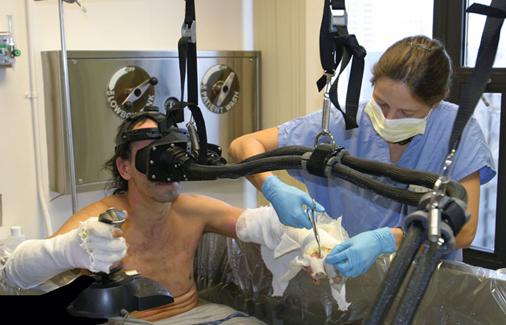Virtual Reality Treatment is a Game Changer for Chronic Pain

Since the advent of video games, researchers have questioned the effects and practical uses of the entertainment media. From effectively replacing expensive training exercises, to treating depression: video games have continued to prove that they have the ability to create useful and meaningful change in people beyond simple entertainment. It comes as no surprise then that virtual reality treatment is the next step in easing chronic pain.
With an increased interest in VR as a viable option in gaming, devices have increased in quality, while decreasing in cost. This has allowed researchers to begin effectively implementing the use of virtual reality treatment in clinical studies. Professor of Psychology at the University of Washington, David Patterson, has been using the technology to help reduce pain in patients who have suffered burns, using an immersive and engaging distraction from pain.
The theory behind it is that there’s only so much attention available to process pain, and if you’re able to pull that attention away, they think about the pain less and they experience it less.
Anyone who has had a burn knows how painful they can be, and for those who have suffered intense burns, the healing process can be even more painful. According to Patterson, in order to prevent infection and keep wounds healthy they must be cleaned regularly. The key, according to the professor, is not just to use virtual reality as a way to distract patients from pain, but to engage them with the game.
David Patterson put his brain together with researcher Hunter Hoffman in the early 90’s to put a game called “SnowWorld” to the test on burn patients. The virtual reality treatment transports patients to a snow covered world where they are tasked with throwing snowballs at snowmen. Patients who played the game noted that they felt less pain, and brain imaging done by Hoffman and Patterson confirmed this. Ultimately, the parts of the brain that control pain experienced less activity when engaged in virtual reality.
Patterson isn’t the only one using VR to treat chronic pain. Director of the Pediatric Pain Management Clinic at the Children’s Hospital in Los Angeles, Jeffrey Gold, is using virtual reality to treat children at his clinic. Using the Samsung Gear VR, they are distracting kids from the stress and pain of certain procedures, such as drawing blood.
One game in use by the clinic, “Bear Blast”, is similar to SnowWorld. Like the VR edition of “Rez”, players are set on a rail and when they fix their head in position to focus on bears in the game, they can fire snowballs at them. Gold calls the process “top-down inhibition”, a process in which the VR encourages patients to use their natural ability to get beyond pain by engaging them in another task. Essentially, it is helping patients push their mind over matter.
It is important to note that there is a difference between the games being used to treat patients, and the model of standard games. Matthew Stoudt, CEO of AppliedVR, a company that specializes in therapeutic virtual reality treatment games, believes that games intended for pain management need to break from the “live-die-repeat” model and focus on a constant “cognitive load”. This effectively detaches patients from their pain and keeps the distracted.
“You can’t simply do continuous play at the same pace and engagement, because that creates a cognitive burnout. So you have to figure out the right way to build the experience up to put more cognitive load on the patient and give them a reprieve without breaking the experience itself.”
This is what “Bear Blast” does for children, and what “SnowWorld” has done for burn patients. Creating a world that is engaging, distracting, and challenging is key to the treatments success. Jeffry Gold sums up the game “Bear Blast” and it’s challenges perfectly:
You’re going up levels, and you start with a couple bears, there’s five, 30, 60. You do other things as you increase into other levels. Kids like that reinforcement of getting to the next level, earning points and racing against the clock.”
According to Professor Patterson, the development of gaming technology has allowed researchers in the medical field to apply virtual reality treatment with greater ease. Where the cost used to be in the tens of thousands of dollars, a few hundred is all it costs now, and this break in cost is allowing researchers to expand what VR can do to manage anxiety and chronic pain in patients.
An issue virtual reality is addressing in the treatment of patients with chronic pain is rehabilitation. Movement often triggers greater pain in patients. Studies show however that physical therapy is an important part of the healing process. Patterson further addressed how VR aids in rehabilitation:
“The primary treatment for chronic pain is movement, but a lot of people with chronic pain are afraid of moving. So there’s now some paradigms out there that encourage movement through VR but also address the fear of movement that people have.”
The engagement and distraction of virtual reality addresses the anxieties patients have with movement. Often it is not enough to simply tell the patient to move, as their fear of pain can cause them to react to treatment negatively. When engaged in VR, motivation is easier to come by, and patients have even stated that they enjoyed the treatment so much they forgot about their pain all together.
Gold acknowledges that every patient has different needs and that a person accustomed to VR may find the games too easy to be distracting. His confidence is not at a loss however, as both software and hardware evolve they will continue to offer more varied and effective ways of managing pain. He went on to note that even multiple rounds of VR sessions show good outcomes for patients, suggesting that the quality of treatment does not diminish over time.
As costs continue to decrease, it may even be possible for patients to be prescribed virtual reality devices as a way to manage pain from their homes with the guidance of their physician. With the portability of these devices, patients need not head to the office for a visit, but could simply saddle up and play a few rounds of their treatment before beginning their day. Not a bad way to traverse the road to recovery.
Both Gold and Patterson believe that more options will be available with your next medical procedure over time. Although pain medication is an important, useful, and relatively safe tool, they can lead to addiction. Virtual reality is a safe, drug-free alternative that would allow patients to get away from pain, rehabilitate, and avoid side effects.
This isn’t the only method in which games have been used to generate well being. In a TED Talk in 2012, Jane McGonigal, designer of alternate reality games, revealed a game she created to help her heal her brain after a serious concussion. The game dubbed “SuperBetter“has since gone on to help people with all types of illnesses, and has even been used as a motivational tool.
Overall, as medicine, technology, and games continue to advance we will likely see more treatments that incorporate the use of all three. Exciting times are ahead for virtual reality and the application of such devices in the treatment of illness, pain, and trauma. Let it never be said that games do not have a place in the wellness and progression of human beings.
What do you think about virtual reality treatment being used to ease chronic pain? How have games helped you achieve wellness? Sound off in the comments below!

Charles Douglas734 Posts
Deep in the mountains of the south west lives a man who writes game editorials, makes YouTube Videos, and is an overall mega nerd. An avid believer in Unicorns, and your new all star line backer, Number 34, CHARLES DOUGLAAAAAAASSSS!!!!












